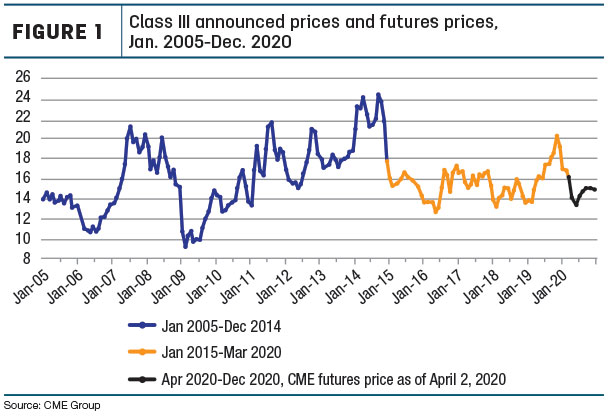No one really knows where this is all headed for the world, the nation or the dairy industry, but an almost certain outcome is that the hoped-for recovery of prices and profitability may have to wait another year.
Figure 1 shows Class III milk prices from January 2005 through December 2020 (future months estimated as of April 2, 2020). In July 2019, the Class III price finally broke out of a cyclical low for the first time in four-and-a-half years and continued to rise to a much needed $20.45 per hundredweight (cwt) in November 2019. Dairy farmers were finally beginning to breathe a sigh of relief, pay off some debt, replace capital assets and build back working capital. Then, news of a new virus started coming out of China.

The much-needed recovery has stalled. Has there been an overreaction by markets? Probably so, but what is not in doubt is that the pandemic has disrupted worldwide commerce, and it will take time to rebuild business, put people back to work and normalize trade and consumption patterns. Depending on how long recovery takes, it could mean some tough conversations.
Dr. Anthony Fauci, the White House adviser on infectious diseases, made a comment that he hoped the critique of him would be that he was too cautious. That is my hope as well. I hope this pandemic all blows over quickly, we get back to normal and have a quick recovery back to profitability. I will happily be the first to criticize myself for being overly cautious. Until then, I’m reminded of the need to remain optimistic but plan for potential risks ahead.
Breaking down the challenges
Potential scenarios are many and a bit daunting. Let’s break the challenge down by what risks we may face today versus next week or the months ahead, and look at some potential strategies. I’ve also included some potential resources. There are many resources and more coming. One resource that addresses multiple risks can be found on the University of Wisconsin Extension website.
1. Today’s challenges
Bills are due
From January until the close of trading on April 2, Class III milk futures prices for the May contract have fallen from $17.25 to $12.88 per cwt, a decline of $4.37. For a 100-cow dairy, that is approximately $8,750 less revenues for one month (approximately $175,000 for a 2,000-cow dairy) with which to pay bills.
Potential strategies and resources
Be fully transparent with lenders and creditors. Consider a draw from your line of credit, new bridge borrowing or partial payment plans. Take advantage of government programs and stay informed of new ones, such as the “Paycheck Protection Program” that provides forgivable loans for employee and other eligible expenses.
Dumping milk
With supply chains disrupted, a last recourse is dumping milk. Hopefully instances will remain isolated. (Be optimistic, but plan for the risk.) Losses are likely to be shared across the pool of producers, meaning even if you were not asked to dump your milk, you may still share the cost.
Potential strategies and resources
Document losses, dumped milk or otherwise, that are a result of the pandemic (written records, photos, dates, etc.). Government relief programs may require documentation for eligibility. Be aware that milk dumped into manure storage facilities or spread on fields could impact your nutrient management plan.
Stop the spread
When sick, employees, family members and you can’t milk cows, feed calves or make clear-headed decisions. As farm business owners, bosses and rural community leaders, you are the leaders of your community and on the front lines to lead the charge to keep the virus out. People will follow your example.
Potential strategies and resources
Talk early and often with your employees about “Social Distancing” and other steps to minimize the risk to co-workers, family and friends. Clean and sanitize break rooms and other common spaces frequently. Check out “COVID-19 Guidance for farm employers.”
Manage stress
The scariness of the virus itself, social isolation and financial worries are taking a toll. Chronic stress can impact mental and physical well-being, relationships and decision-making.
Potential strategies and resources
Take care of yourself so you can take care of others. Lead regular conversations with your spouse, employees and others that create an environment of openness for expressing needs and fears. Find resources at “Resilient Farms, Families, Businesses & Communities: Responding to Stress.”
2. Next few weeks’ challenges
Sick employees, family members, milk haulers and processing plant workers
Sickness could impact the normal operations of the dairy. With spring work around the corner, this is even more of a concern.
Potential strategies and resources
Prevent the spread of the disease (see above.) Develop contingency plans for how work will get done, including cross-training, written standard operating procedures and neighborhood labor pools. Contact your haulers, vets and others who are a routine part of operations and ask them what their contingency plans are or what you need to do to prepare for a COVID-19 outbreak among them. Prepare plans for how to dispose of milk for short disruptions that might be caused by the dairy plant having to quarantine due to a virus outbreak.
Liquidity/cash flow/paying bills
If prices stay low, then greater actions will be needed to increase cash flow.
Potential strategies and resources
Implement changes in practices that increase short-term cash flow, including finding cheaper ration ingredients; negotiating lower prices; making interest-only payments on loans; selling unused or underutilized capital assets (cows, machinery, etc.); seeking new operating loans or restructuring existing loans; and making changes in milking, feeding and other procedures that reduce labor and other inputs. Cull or dry-off low-producing cows early.
3. Months ahead challenges
Solvency or loss of equity
The last four-and-a-half years of poor profitability has taken a toll on owners’ equity. While not unusual in the farming business, the length of this downturn reduced the resiliency of businesses to take another hit. Continuing erosion of equity due to financial impacts from COVID-19 may necessitate a tough conversation on what is best for the future of the operation.
Potential strategies and resources
Ask and answer some tough questions:
- What is the trend of profitability, debt and equity?
- How will these change under different price scenarios (Class III milk price of $18 and higher, $15 to $18, or lower than $15)?
- How much more equity are you prepared to spend to wait it out?
- Are there alternatives for partial liquidation?
Identify your profile
Based on your early answers to the questions above, you may fit one of three profiles:
-
Long-haulers: I’m in the business for the long run. I know an economic downturn is coming, so I’ll hunker down and cash flow until profitability returns. Big question: How do I cash flow in the short run?
-
Guardian transitioners: I have equity in this business, and I am going to guard against any further erosion by proactively managing transition, exit or partial exit and preserve the equity I have. Big question: How do I exit successfully with the most equity possible?
- On-the-fencers: I’m unsure. I’m too young to retire, and I’m too old to start over. I want to farm, but I don’t want to go poor doing it. Big question: How do I analyze this situation and make decisions?
We’ll take an in-depth look into each profile in upcoming articles.
Conclusion
My father taught me, and I have tried to pass on to my kids, the three circles – the circle of control, the circle of influence and the circle of no control. His lesson was to focus on those things in my inner circle of control. Every minute spent thinking about the circle of no control was a minute not using my creativity to solve the problems I can control.
Dairy farmers, this downturn in your farm finances is due to something completely outside of your control. COVID-19 is an enemy that struck with little warning; there was no ability on our part to be ready for it. Unfortunately, that does not take away the financial sting, nor the future challenges you face. As hard as it is, my father’s message would be to realize this was not in any way something of your making or something for which you could have prepared. Instead, focus your energies and management creativity on what you can control, even if it means a tough conversation. ![]()
ILLUSTRATION: Illustration by Kristen Phillips.

-
Kevin Bernhardt
- Farm Management Specialist
- University of Wisconsin Extension,
- Center for Dairy Profitability and UW – Platteville
- Email Kevin Bernhardt






